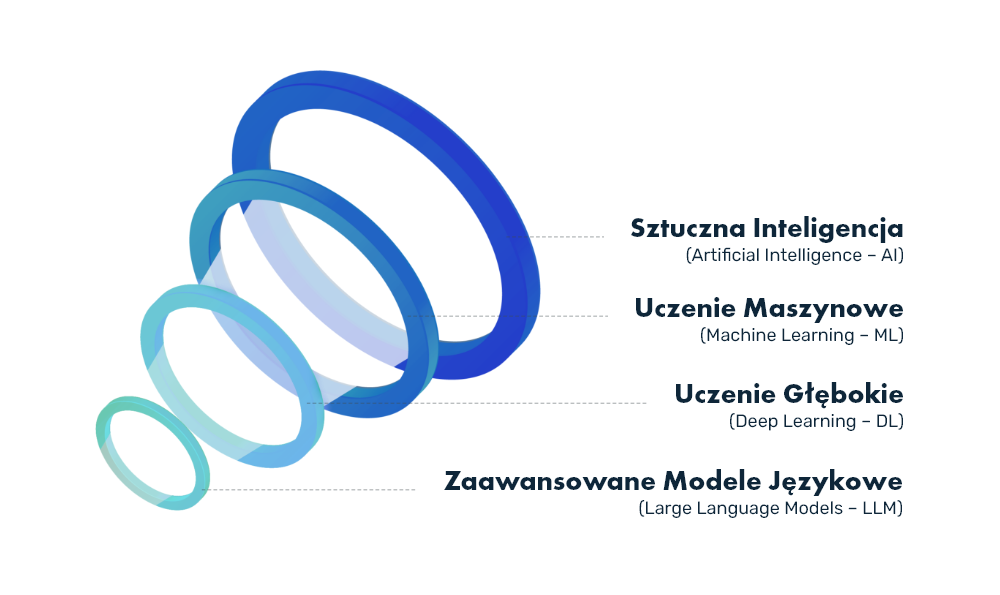What is artificial intelligence all about?
Artificial intelligence (AI) is a very capacious and rather conventional term. In a broad context, it refers to the ability of machines (computers) to learn and imitate human behavior.
Important!
The distinguished conjunction and in the above sentence is significant because artificial intelligence is a slightly different concept from machine learning (ML). Machine learning involves training computers not to mimic human behavior or create their own, but only to reproduce behavior patterns based on analyzed data and recognized patterns. Machine Learning is thus part of a collection called “AI.”
Nowadays, the term “artificial intelligence” is often used in a simplistic way – for example, as a term for advanced language models (LLM – Large Language Models), which generate text based on millions of processed contents (the most popular language model at the moment is the one by OpenAI – ChatGPT). In fact, these models are only a component of Deep Learning (DL), a subset of Machine Learning, which in turn belongs to the set of AI, or artificial intelligence, techniques. So while this is quite a simplification, it should not be considered an error.

AI on a daily basis
The year 2023 can boldly be called the year of artificial intelligence. AI is an acronym that has taken over the headlines of portals, newspapers and news service strips. It has found its way into everyday conversations and even into pop culture (the high-profile case of the lead-in to the TV series Secret Invasion, which was almost entirely created using generative AI). In particular, the issue of “creating” content with artificial intelligence – whether text, graphics or video – is controversial. AI has penetrated not only the business world, although it is speculated that it will cause the most noticeable changes there.
Already, new jobs are emerging and others are going away. And while it may seem like the volte-face happened very quickly and came virtually out of nowhere, the reality is that work on artificial intelligence has been going on for years. AI is opening up new opportunities for many of us, and – while it still raises moral and legal questions, especially on the ground of content generation – there are areas where using AI language models can significantly help you achieve better results without thinking about whether you should do so. One of them is e-commerce.
How to use AI in e-commerce?
Running an online store is a business that requires entrepreneurs to be flexible and constantly adapt to the changing laws of the market. Overlooking the opportunities offered by the use of artificial intelligence in e-commerce means closing yourself off to many potential benefits. What specifically can AI help with?
- Customer service
- Recommendation system
- Enhancing security
- Product Search
- Price list management
- Increase the credibility of the store
Use AI in customer service
User experience (UX) begins long before the order is placed. Already hearing about the brand for the first time starts this experience, so it is important to – as a brand precisely – create a good first impression and thus encourage the user (perhaps a future customer) to interact further.
Particularly important is how the brand will respond to contact from the customer. Acquiring leads (marketing contacts) is usually a tedious and time-consuming process, so the moments when a customer comes to the company on his or her own – whether with an inquiry or a specific intention to buy a product – should be appreciated and should be able to respond accordingly.
Many e-commerce businesses encourage customers to get in touch using a form on the website, but chatbots, which are visible on the site as a widget and allow users to ask relevant questions right away, are becoming increasingly popular. What sets chatbots apart from standard forms is often the promise of a quick response. The chat window is usually active as long as the user stays on the page, so the worst that can happen is that the customer’s inquiry is left unanswered. Artificial intelligence will help avoid such a situation.
For AI’s troubles
AI-supported chatbots are a solution that will help your customers by answering frequently asked questions, providing basic information about your store, and recommending products based on user input. The e-commerce chatbot will also record the conversation and provide a transcript of it to the customer service representative so that he or she can continue the conversation with the full context of the conversation.
Chatbot AI is not a solution that will replace an employee, but it is capable of saving the employee a lot of time and ensuring that he or she does not have to tear himself or herself away from work just to answer repetitive questions (such as those about store opening hours or the possibility of picking up an order in person).
Create a recommendation system based on artificial intelligence
Each customer has his or her own preferences – they may be interested in a particular product category or in products from a single brand. If you remember the small neighborhood stores where the saleswoman knew the customers by name, you probably recall how, at the mere sight of a familiar person, she reached for her favorite products and took them off the shelf. When running an online store that serves hundreds of customers, it is impossible to know and remember the expectations of even a fraction of customers. Fortunately, AI can help us solve this problem.
Recommendation engines are applications that learn about users’ accounts – including their transaction history. By processing this data, the engine is able to create a personalized recommendation for each customer, thereby increasing conversion, average order value and service satisfaction.
Example:
Ms. Sophia runs an online toy store. It offers thousands of products, including LEGO sets, board games, but also toys for the youngest children. Ms. Sophia uses a recommendation engine that analyzes customers’ buying habits. As a result, Mr. Gregory, who buys only board games for his teenage son at the store, will receive recommendations during his shopping and in the newsletter that include games that fall into a similar age category, instead of – for example – a dollhouse.
Fight fraud with AI
Online shopping continues to grow in popularity, and there is no indication that this trend will reverse anytime soon. As the number, and perhaps most importantly the value, of transactions increases, so does the number of online shopping scams. It’s not easy to track down suspicious activity on a store’s website on your own and verify which ones are actually dangerous.
What behaviors can AI track? For example, placing orders with false data, generating very many orders from one account at the same time, or acting to buy out the entire run of a hard-to-find product. The app will detect such attempts and, depending on how you configure it, will block unwanted actions or inform the store’s support.
Advanced fraud prevention tools are based on analysis of customer behavior, but also the devices they use, the location from which they order, or the payment methods they choose. The verified data is used by the application to assess the risk of a given transaction. If it exceeds a predetermined threshold, the application will take a predetermined action.
Important!
It can be a big challenge to properly set up your e-commerce fraud prevention software. Overly restrictive rules can cause the software to block transactions made by honest customers who have behaved in unusual ways. Too loose, on the other hand, would make one question the wisdom of using safeguards of this kind. Nonetheless, even having to manually review each unusual submission is a great value for an online store that can help avoid fraud.
Give the ability to search for products with graphics or voice
Image recognition services such as Google Lens have been available for many months now. With such apps, smartphone users can take a picture of any product and then search for it in the offerings of online stores. This is a huge competitive advantage that is worth exploiting.
Image search also uses artificial intelligence – it processes a given image, compares it with millions of similar ones, to then search for and present the customer with a list of offers containing that or a similar product.
Example:
Mr. Bartholomew is walking through a shopping mall. In the store window of one of the stores, he notices headphones priced at PLN 999. This is the model that Mr. Bartholomew has been looking for a long time, but this one was still unavailable. A customer could now walk into a store and buy the product for the store price, but he or she could also take another action: launch a photo recognition app and take a picture of the headphones. Artificial intelligence will process the photo and compare it with offers from online stores Thanks to this, Mr. Bartholomew will learn that the same model of headphones is offered in many places cheaper by up to PLN 300.
Voice search works similarly, although here – to find a specific model of headphones – Mr. Bartholomew would need to know the name of the headphone. So it makes it difficult to search for a product we see or have heard of, but don’t know its designation.
Implement dynamic pricing
If you offer hundreds or even thousands of products on your online store, managing your price list can be a real challenge. Sometimes product prices need to be adjusted to the market situation: more expensive materials, rising transportation or production costs. There are tools that can manage prices on the fly, and not only in the situations mentioned.
AI-powered software can independently price products and adjust them according to the conclusions it draws from processed data. In this way, it can lower or raise the price of the product depending on exchange rates, rising costs or… competitor prices.
Ensure credible feedback
The fight against false opinions is said to be doomed to failure in advance. Almost every entrepreneur who operates on the Internet has to reckon with reviews that damage the company’s good reputation, but there seems to be no good solution to this. Especially in the case of large stores, we can talk about Sisyphean work – there are so many opinions that it is impossible to verify each of them. Moreover, removing negative reviews is absolutely not a way out of a difficult situation.
So what can be done to ensure that only credible reviews appear on the store’s website? There are solutions supported by artificial intelligence that analyze opinions and recognize content patterns. On this basis, they flag potentially false entries. Properly configured filters will allow you to remove reviews that do not meet the guidelines or direct them to be moderated by a store employee.
Unfortunately, you can implement this solution only on your own store page, that is, where you have full control over the published content. Unreliable reviews appearing in various aggregators can be reported to the administration of these portals, but the process of removing them is usually tedious and time-consuming, if possible at all.
Summary
That’s all we’ve prepared for today. There are, of course, more applications of artificial intelligence in e-commerce, we have selected the most interesting ones. It is worth bearing in mind that the development of AI has now entered a phase of extremely rapid growth. So it’s not unlikely that in just a few weeks or months, more solutions will emerge to help artificial intelligence (or machine learning) run your online store in entirely new ways.


